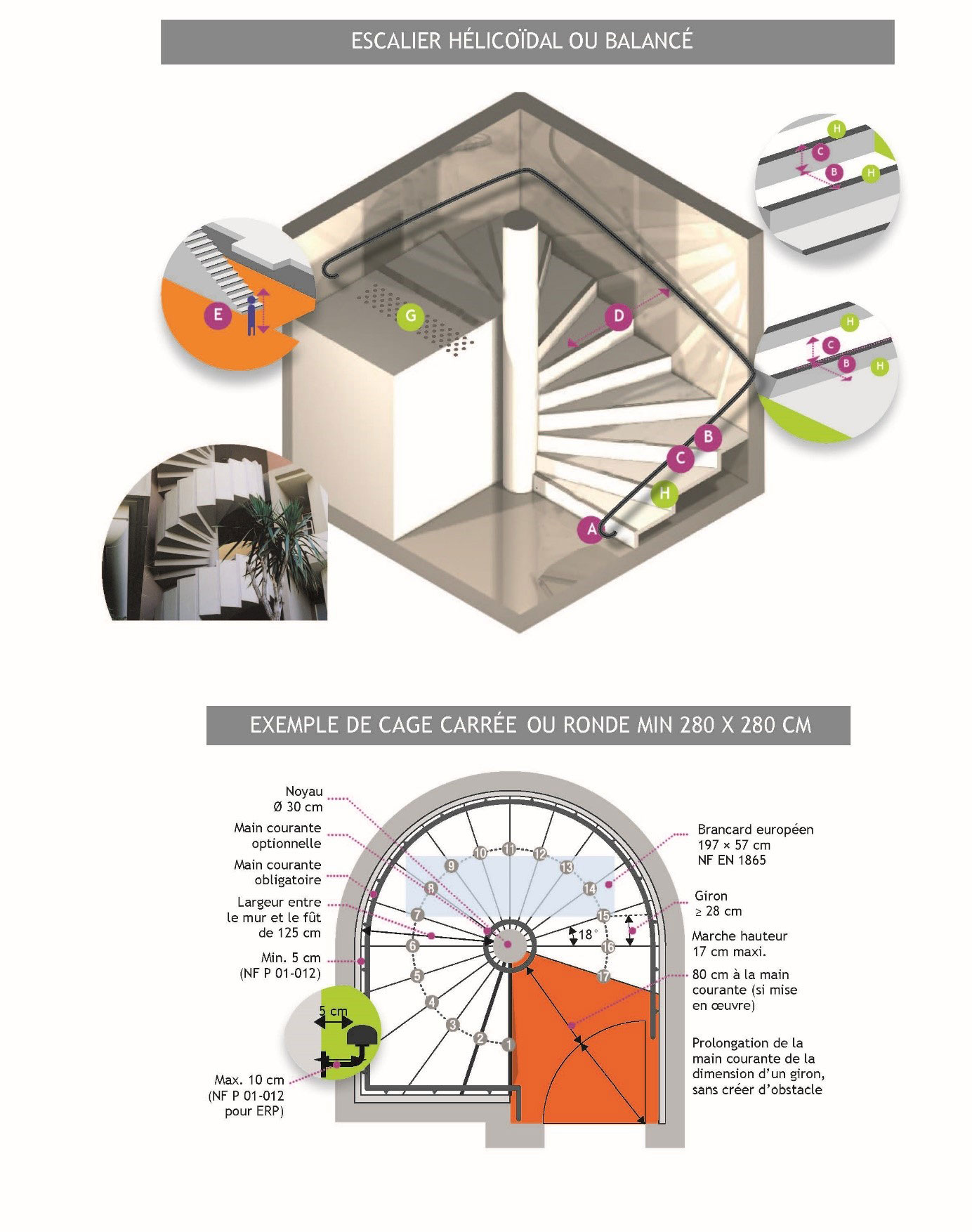“Stairs are integral to the functioning of any building or communal structure. This functionality depends on meeting the architectural geometry constraints… “
In any building, the staircase is a vital and regulatory component. Its functionality depends on meeting architectural geometry constraints, complying with user safety regulations and providing a link between different levels. The proportions and design of winding staircases allow a perfect fit with building requirements. A simple, easy-to-install solution in any room. Find out more about these evocatively named staircases.
Winding staircase architecture, a major innovation
Winding staircases are designed to provide maximum clearance with minimum set back. They link floors effectively with a minimal footprint. A genuine technological feat, witness to the extensive skills and expertise developed by PBM. The steps start to wind as of the first straight section. The steps curve progressively around the central core while maintaining their initial tread. The curve is negotiated using trapezoidal steps to form the straight section. This type of staircase does not require intermediate landings. The rotation may be 90°, referred to as quarter-turn or L-shaped staircase, or 180° with a half-turn to face the initial direction. The curve may begin at the top of the flight, mid-point in winding stairs or at the foot of the stairs, thus creating a design focal point. Our models meet the needs of communal areas and multiple-story villas.
Why choose an NF mark PBM staircase?
All our stairs have CE and NF marking.
Why have both NF and CE marking and what is the added value?
Some staircases have both CE and NF marking as extra evidence of their quality.
Where harmonised features are involved (requirements given in Annex ZA of standard NF EN 14843), CE marking requires a manufacturer to declare performance values but does not enforce minimum values.
This means that not all CE-marked products necessarily have the level of performance required to conduct building work in accordance with good professional practice such as defined in the French DTU code of practice.
The precast concrete stairs NF mark:
- certifies that the stairs meet a performance level conform to the specifications of the NF certification rules
- guarantees that the product performance requirements have been audited by an independent body and that the manufacturer has been found to comply with these requirements in a sustainable and continuous manner
- guarantees the buyer that the stairs are designed for building structures in accordance with good professional practice and, specifically, with the French DTU code of practice.
- The precast concrete stairs NF mark came into force in 2008.
Choose a winding staircase from the PBM offer
PBM offers a range of precast concrete models designed to cut building costs while maintaining the structure’s strength and solidity. Our catalogue contains a wide range of staircases with a variety of configuration options to suit your every need; winding stairs with central column, winding stairs with open well, double winder stairs with quarter or half turn.
To ensure that client requirements are fulfilled, we regularly update our catalogue with new models designed both for single-family homes and group housing projects. Click here to view all our models directly on our website.
Contact our sales representatives for a comprehensive assessment.
OUR CONCRETE ANGLED STAIRCASES
Rules and regulations governing winding staircases
Buildings Open to the Public (ERP)
Facilities Open to the Public (IOP)
DIMENSIONS
A Tread line at a distance of 50 cm from the exterior wall according to the decree of 01/08/06 (at a distance of 60 cm from the core, column or open well so as to comply with fire regulations – Decree of 25/06/80 – Art. CO56).
B Tread: T ≥ 28 cm on the tread line (exterior tread < 42 cm)
C Step height 13 cm ≤ H ≤ 16 cm
It is strongly advised that all the steps should be the same height. There is a permitted tolerance on the first step provided that its height is no less than 13 cm Recommended: 60 cm < 2H+T < 64 cm
D Width between handrails ≥ 120 cm (which gives an inter-wall width of 140 cm)
E Clearance height h ≥ 2.00 m and, if possible 2.20 m
ENCROACHMENT AND USAGE
F All staircases must have a handrail on each side unless the diameter of the central column ≤ 40 cm (1 single handrail installed on the exterior side):
• Height between 80 cm and 100 cm measured from the step nosing
• Horizontal projection equal to 1 tread length beyond the 1st and last step, without obstructing traffic, excluding the handrail on the side of the central column if it has a tactile contrast indicating a landing
• Continuous (except where other special conditions apply on the exterior side), rigid and easy to grip
• Easily distinguished from the supporting wall using special lighting or visual contrast
SAFETY
G Warning at a distance of 50 cm (except where other special conditions apply) from the last step of each flight using a system of visual and tactile contrasts
H Step nosings with a contrasting finish to the rest of the stairs:
• Over a horizontal distance of at least 3 cm
• Non-slip
• Overhang of the riser ≤ 1 cm
Riser of at least 10 cm – the risers on the 1st and last step shall contrast visually with the other steps.
1 or 2-step staircases are prohibited.
Spiral staircases must wind continuously with no landings other than those at each floor.
GROUP HOUSING
(communal areas)
DIMENSIONS
A Tread line at a distance of 50 cm from the exterior wall
B Tread: T ≥ 28 cm from the tread line
C Step height H ≤ 17 cm
Recommended: 60 cm < 2H+T < 64 cm on the tread line
It is strongly advised that all the steps should be the same height. There is a permitted tolerance on the first step
D Width between handrails ≥ 100 cm (which gives an inter-wall width of120 cm with 2 handrails)
E Clearance height h ≥ 2.00 m and, if possible 2.20 m
ENCROACHMENT AND USAGE
F All staircases must have a handrail on each side unless the diameter of the central column ≤ 40 cm (1 single handrail):
• Height between 80 cm and 100 cm
• Horizontal projection equal to 1 tread length beyond the 1st and last step, without obstructing traffic, excluding the handrail on the side of the central column if it has a tactile contrast indicating a landing
• Rigid, easy to grip and continuous (except where other special conditions apply on the exterior side)
• Easily distinguished from the supporting wall using special lighting or visual contrast
SAFETY
G Warning at a distance of 50 cm (except where other special conditions apply) from the last step of each flight using a system of visual and tactile contrasts.
H Step nosings with a contrasting finish to the rest of the stairs:
• Over a horizontal distance of at least 3 cm
• Anti-slip
• Overhang of the riser ≤ 1 cm
Riser of at least 10 cm – the risers on the 1st and last step shall contrast visually with the other steps.
Option of building 1 or 2-step staircases.








